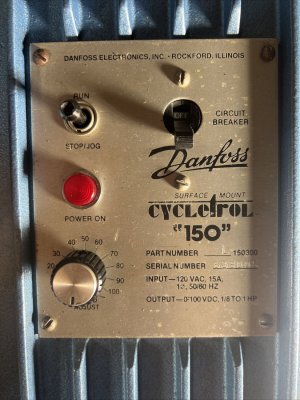An afterthought, if I may. A 3 position toggle switch on a machine like a lathe is a dangerous proposition. A single phase AC / Induction motor only switches on the start winding necessary to reverse the motor when (near) zero speed is achieved. If the reversing switch is quickly moved from FWD to REV, the motor will continue to run in whatever mode it was started. As in, it won't reverse, it just keeps running.
This can easily mean that while intending to switch off, the motor is not switched off, but continues to run. I use a large number of 3 position switches in my hobby. I have large hands and a 3 position switch will quite often "overshoot" the center off position. It is usually something that I feel, but sometimes too late to center the switch. In my hobby, this results in a temporary short circuit on low voltage DC equipment, not a big deal. AC line voltage is another matter entirely.
I have a large (3/4 chuck) drill that I have "adapted" by adding a toggle switch to allow reversing. By using a 2 position switch in addition to the trigger, most such "accidents" are avoided. I also located the "added" reversing switch in a location that is a problem to get to. This also helps negate any "accidental" operation.
It is this "accidental overshoot" of the off position that causes problems. During normal operation, the off position is easily felt. In an "emergency" situation where overshoot will cause unintended results that problems arise. Please keep this in mind for modifications.
.
This is why (well, one of the reasons) I use a Danfoss Cycletrol to run my lathe's 3/4hp Baldor DC motor:

I've got it powered off a hospital grade power bar inside the lathe cabinet and that has an on/off switch. Once turned on, you have to engage the CB on the control panel to power the panel. The "run" switch itself is a momentary on switch and 3 position, sprung loaded to the center. You have to lift the switch up to turn the motor on and you control the speed with the rheostat.
Should you get into a panic situ and slam the switch down, it only goes to the "jog" position. The Jog position only powers the motor when you hold the switch there, so slamming past the center on a panic off means you are still only going to turn the motor off, even if you do blow through the center off position.
You also have the option of hitting the CB and turning the motor off, so all you really need to do is get your hand to the top of the panel and swipe down. No matter what you hit for switches, the lathe turns off. the Cb, being a CB, is also "half sprung" to the off position, so it takes very little force to trip it. Dragging a hand over it, even if lightly, will trip it to off.
The jog position has also proven very useful in other situations where I just want to turn the spindle a slight amount without having to grab the chuck.
The cycletrol also maintains a constant rpm under load, compensating for increases (and decreases) under loads. Combined with the Baldor motor, the lathe runs dead smooth, consistent speeds and more torque than I'll ever need on my 10F.
I originally bought the cycletrol for the speed control function, but the more I use it, the more useful I find it. Was a worthwhile purchase.
Not trying to sell anyone on it, just describing how well it works for my setup. YMMV......


